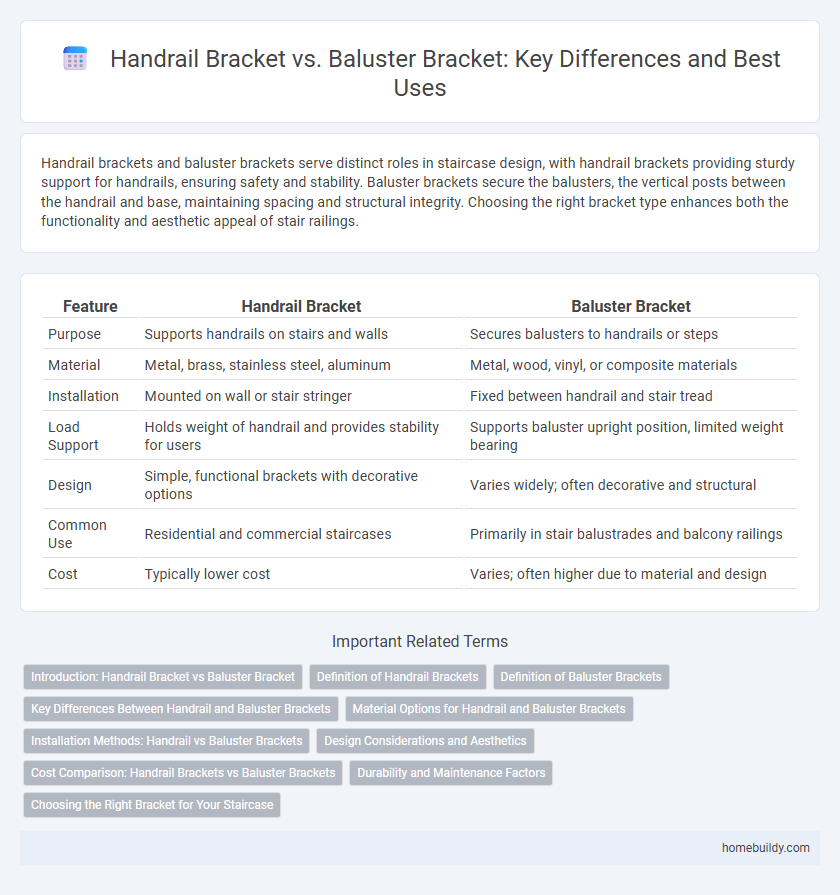Handrail brackets and baluster brackets serve distinct roles in staircase design, with handrail brackets providing sturdy support for handrails, ensuring safety and stability. Baluster brackets secure the balusters, the vertical posts between the handrail and base, maintaining spacing and structural integrity. Choosing the right bracket type enhances both the functionality and aesthetic appeal of stair railings.
Table of Comparison
| Feature | Handrail Bracket | Baluster Bracket |
|---|---|---|
| Purpose | Supports handrails on stairs and walls | Secures balusters to handrails or steps |
| Material | Metal, brass, stainless steel, aluminum | Metal, wood, vinyl, or composite materials |
| Installation | Mounted on wall or stair stringer | Fixed between handrail and stair tread |
| Load Support | Holds weight of handrail and provides stability for users | Supports baluster upright position, limited weight bearing |
| Design | Simple, functional brackets with decorative options | Varies widely; often decorative and structural |
| Common Use | Residential and commercial staircases | Primarily in stair balustrades and balcony railings |
| Cost | Typically lower cost | Varies; often higher due to material and design |
Introduction: Handrail Bracket vs Baluster Bracket
Handrail brackets and baluster brackets serve distinct purposes in staircase construction, with handrail brackets designed to securely mount handrails to walls, ensuring stability and safety. Baluster brackets, in contrast, connect balusters to the stair tread or base rail, providing support to the vertical posts that prevent falls. Understanding the functional differences and installation locations of handrail versus baluster brackets is essential for proper stair railing assembly and code compliance.
Definition of Handrail Brackets
Handrail brackets are hardware components designed to securely attach handrails to walls or other surfaces, ensuring stability and safety in staircases and walkways. Unlike baluster brackets, which connect balusters or spindles to stairs, handrail brackets primarily focus on supporting the handrail itself for ergonomic grip and structural integrity. These brackets typically feature a mounting plate, an arm, and a rail socket or clamp specifically engineered for handrail profiles and materials.
Definition of Baluster Brackets
Baluster brackets are hardware components designed to secure balusters--the vertical posts supporting a handrail--ensuring stability and safety in stairways and railings. Unlike handrail brackets, which primarily attach the handrail itself to walls or posts, baluster brackets focus on fixing balusters to the base or rail, providing structural integrity and aesthetic alignment. These brackets are essential in maintaining the proper spacing and support of balusters, contributing to both the safety and design of stair systems.
Key Differences Between Handrail and Baluster Brackets
Handrail brackets are specifically designed to support handrails, providing stability and safety along staircases and ramps, while baluster brackets primarily secure balusters to the stair tread or railing structure. Handrail brackets feature mounting plates optimized for wall attachment, often with adjustable angles for varying rail inclines, whereas baluster brackets prioritize vertical or horizontal baluster positioning within the railing system. The key difference lies in their functional roles: handrail brackets ensure handrail support for grip and navigation, and baluster brackets reinforce the structural integrity and spacing of balusters.
Material Options for Handrail and Baluster Brackets
Handrail brackets and baluster brackets differ significantly in material options tailored to their specific functions and aesthetic roles. Handrail brackets are commonly crafted from durable metals like stainless steel, brass, and aluminum, providing robust support and corrosion resistance for safety and longevity. Baluster brackets often utilize a wider range of materials, including wrought iron, wood, and composite materials, to complement different stair designs while maintaining structural integrity.
Installation Methods: Handrail vs Baluster Brackets
Handrail brackets typically require secure mounting on a wall or post using screws and anchors to support the handrail's weight and provide stability. In contrast, baluster brackets are installed by attaching directly to the handrail and the base or stair tread, often using nails or screws for alignment and spacing of vertical balusters. The installation of handrail brackets demands precise positioning to ensure ergonomic height and safety, while baluster brackets focus on evenly spacing and securing the balusters for structural integrity and aesthetic consistency.
Design Considerations and Aesthetics
Handrail brackets and baluster brackets serve distinct roles in staircase design, with handrail brackets primarily supporting the handrail and baluster brackets securing the vertical spindles. Design considerations for handrail brackets emphasize sleek profiles and discreet mounting to complement various architectural styles, while baluster brackets often prioritize structural stability and alignment of balusters. Aesthetically, handrail brackets contribute to a polished, seamless look, whereas baluster brackets can be more robust, enhancing the visual rhythm and support system of the staircase.
Cost Comparison: Handrail Brackets vs Baluster Brackets
Handrail brackets generally cost less than baluster brackets due to simpler design and lower material requirements. Baluster brackets often involve more complex manufacturing and additional decorative elements, which increase their price. Choosing between the two depends on budget constraints and the desired aesthetic for the staircase.
Durability and Maintenance Factors
Handrail brackets are typically made from heavy-duty materials like stainless steel or brass, offering superior durability compared to baluster brackets, which are often constructed from lighter metals or plastic composites. The robust design of handrail brackets ensures minimal wear and tear, reducing maintenance frequency and costs over time. Baluster brackets may require more regular inspections and replacements due to their relatively lower endurance against environmental factors and mechanical stress.
Choosing the Right Bracket for Your Staircase
Handrail brackets provide strong support for handrails, ensuring safety and stability, while baluster brackets secure the vertical posts that support the handrail. Choosing the right bracket depends on the staircase design, load requirements, and aesthetic preferences, with handrail brackets typically mounted on walls and baluster brackets attached to the stair treads or stringers. Proper selection enhances both functionality and visual appeal, fitting seamlessly with stair materials like wood, metal, or glass.
Handrail bracket vs Baluster bracket Infographic

 homebuildy.com
homebuildy.com